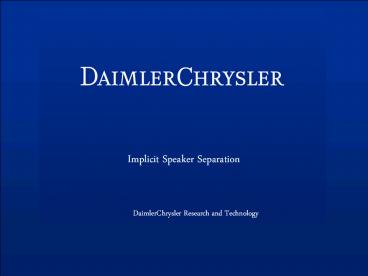Implicit%20Speaker%20Separation - PowerPoint PPT Presentation
Title:
Implicit%20Speaker%20Separation
Description:
Title: Spatial and Statistical Approaches for Separation of Multiple Speakers Author: Julien Bourgeois Last modified by: jbourge Created Date: 12/1/2003 1:04:52 PM – PowerPoint PPT presentation
Number of Views:66
Avg rating:3.0/5.0
Title: Implicit%20Speaker%20Separation
1
Implicit Speaker Separation
- DaimlerChrysler Research and Technology
2
Problem Context
Speech recognition
text
Speaker separation
driver codriver
3
Algorithm Architecture
Spatial
Adaption during driver silences
Min Power
Filter
-
driver codriver
4
Reminder on Least-Mean Square (LMS)
x1 (signal ref)
y1 x1 x2 w2
w2
x2 (noise ref)
- The filter w2 is adapted with the normalized
Least-Mean Square (NLMS) algorithm. - w2(n1) (k) w2(n) (k) - m y1(t)x2(t-k) /s2x2
- Converges if the target is not active speaker
activity detection required - Convergence is assured (in the mean) if
- 0 lt m lt 2
5
Reminder on Least-Mean Square (LMS)
x1 (signal ref)
y1 x1 x2 w2
w2
x2 (noise ref)
- NLMS w2(n1) (k) w2(n) (k) - m y1(t)x2(t-k)
/s2x2 - Adapts slower when the interferer is loud (for
stability)
6
From LMS to Implicit LMS
x1 (signal ref)
y1 x1 x2 w2
w2
x2 (noise ref)
- NLMS w2(n1) (k) w2(n) (k) - m y1(t)x2(t-k)
/s2x2 - Adapts slower when the interferer is loud (for
the stability) - Implicit LMS w2(n1) (k) w2(n) (k) m0
y1(t)x2(t-k) /s2y1 - Adapts slower when the target is loud less
target cancellation - Adapts faster when the output (target) is weak.
- Adapts maybe to fast.
7
Implicit LMS stability condition
x1 (signal ref)
y1 x1 x2 w2
w2
x2 (noise ref)
- NLMS w2(n1) (k) w2(n) (k) - m y1(t)x2(t-k)
/s2x2 - ILMS w2(n1) (k) w2(n) (k) m0 y1(t)x2(t-k)2
/s2y1 - ILMS NLMS with time varying step size
- m (k) m0 s2x2 /s2y1
- ILMS stability condion 0 lt m (k) lt 2
- 0 lt m0 s2x2 /s2y1 lt 2
8
Implicit LMS stability condition
x1 (signal ref)
y1 x1 x2 w2
w2
x2 (noise ref)
- ILMS stability condition
- 0 lt m0 s2x2 /s2y1 lt 2
- Fulfilled ? If yes then
- w2(n1) (k) w2(n) (k) m0 y1(t)x2(t-k)2
/s2y1 - If not then NLMS with
step-size m0 - w2(n1) (k) w2(n) (k) - m0 y1(t)x2(t-k)
/s2x2
9
Implicit LMS stability condition
x1 (signal ref)
y1 x1 x2 w2
w2
x2 (noise ref)
- ILMS stability condition
- 0 lt m0 s2x2 /s2y1 lt 2
- Fulfilled ? If yes then
- w2(n1) (k) w2(n) (k) m0 y1(t)x2(t-k)2
/s2y1 - If not then NLMS with
step-size m0 - w2(n1) (k) w2(n) (k) - m0 y1(t)x2(t-k)
/s2x2
When does it happen ?
10
Implicit LMS stability condition
- We describe the system with
- emismatch how far is w2 from optimum
- eleakage how much driver speech is received
in codriver microphone - ILMS stability condition 0 lt m0 s2x2 /s2y1 lt 2
- is not fulfilled if and only if
- (i) means we are close to optimum
- (ii) means the driver is weak with respect to
codriver - gt NLMS normalization is convenient.
11
From ILMS to BSS (Blind Source Separation)
Dependence measure
w1 and w2 are jointly optimized such that the
outputs are independent.
x1
y1
w1
w2
ILMS (reminder)
y2
w2(n1) w2(n) m y1(t)x2 (t-k)/s2y1
x2
- Replace the noise reference x2 with the best
available reference y2. - No adaption control needed (blind).
- High complexity w.r.t. NLMS or ILMS
w1(n1) w1(n) my2(t) y1 (t-k)/s2y1
w2(n1) w2(n) my1(t) y2 (t-k)/s2y2
12
How does it sound ?
- Microphone signals
- Blocwise adaptation
- Unsupervised NLMS
- Supervised NLMS
- Implicit ILMS
- BSS
- Samplewise adaptation
- Unsupervised NLMS
- Supervised NLMS
- Implicit ILMS
13
Conclusion
- NLMS
- converge fastest (target silent) and
- diverge fastest (double talk).
- 15 dB SIR improvement with perfect double
detection - ILMS
- very robust, no explicit speaker detection
- 10-12 dB SIR improvement
- low compexity
- BSS
- robust and converge fast
- SIR improvement 15 dB
- high complexity
14
SIR Improvement
15
Microphone power ratio
Clean signals
SNR at x1 15 dB































